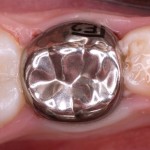
While there has been a general improvement in oral health a large proportion of children still suffer with untreated dental caries. Even with good access to dental treatment, the conventional approach to treating cavitated primary tooth carious lesions has shown limited effectiveness in controlling caries. Consequently, a number of less invasive alternatives have been advocated.
The aim of this study was to evaluate the clinical efficacy of 3 caries management options [conventional restorations (CR), the hall technique (HT), and non-restorative caries treatment (NRCT)] for occlusoproximal cavitated lesions in primary molars
Methods
Children aged 3–8 years old with a primary molar tooth with occlusoproximal caries into dentine were recruited. Children were excluded if they had signs or symptoms of pulpal or periradicular pathology (including pain) or systemic conditions requiring special dental considerations. Only 1 tooth per child was included in the study
Treatments were provided by 12 different dentists (seven paediatric specialists and five post-graduate paediatric students). No local anaesthesia was used for the HT and NRCT approaches. Patients in the HT and CR had reviews twice per year while those in the NRCT group had 3 monthly recalls where plaque disclosing and toothbrushing instructions to parents/children for the whole mouth and site specific for the treatment tooth were performed and the information recorded. The study tooth was cleaned, and fluoride varnish applied to active lesions. Patients were examined at 1 year with a final examination after 2.5 years.
Restoration loss/need for replacement, reversible pulpitis, and caries progression were considered to be minor failures and irreversible pulpitis, abscess, etc to be major failures.
Results
- 169 patients were recruited.
- 52 patients received HT; 52 NRCT; 65 CR.
- 142 patients (84.02%; HT = 40/52; NRCT = 44/52; CR = 58/65) had follow-up data of 1–33 months with a mean time of 26.04 months (±11.15) for the last follow-up.
- 35/169 (24.6%) children presented with at least 1 failure.
- 25 of 142 participants (17.6%) presented with at least 1 minor failure
- 10 of 142 participants (7.04%) experienced at least 1 major failure
|
Outcome at 2.5 Yrs |
Conventional restorations (CR) |
Hall technique (HT) |
Non-restorative caries treatment (NRCT) |
|||
| Number |
( %) |
Number |
( %) |
Number |
( %) |
|
| Minor failure |
14 |
9.9% |
2 |
1.4% |
9 |
6.3% |
| Major failure |
5 |
3.5% |
1 |
0.7% |
4 |
2.8% |
| Cumulative survival rates |
67.2% |
92.5% |
70.5% |
|||
Conclusions
The authors concluded: –
the HT showed a very high success rate (93%) after 2.5 years in high caries risk, young children with occlusoproximal lesions, generally agreed as the most challenging group to obtain good clinical success in, without resorting to sedation or general anaesthesia to treat. Although the success of the NRCT was significantly lower compared to the HT, 70% of lesions in this group did not show signs/symptoms of pulp damage during the study period, and these results were comparable to the control arm (CR). The results of this study strongly high- light doubts over the established standard treatment of surgical caries removal and filling material placement for occlusoproximal 2-surface carious lesions in the primary dentition with relevant caries activity. More so, this study supports the use of alternative caries management options like the HT and NRCT, which are based on biofilm control for the treatment of primary molars.
Comments
We looked at the 1-year results of this study in an earlier blog (Dental Elf – 18th Sept 2014) and the better performance of the Hall Technique has continued to be demonstrated up to the 2.5-year review. In 2016 a Cochrane review of this topic was published (Dental Elf – Hall Technique Blogs) that included 5 trails providing moderate quality evidence to support the use of crows to restore primary molars that have had pulp treatment are extensively restored or badly broken down. While the use of the Hall technique is increasing its use in general practice is still limited. This particular trial was conducted in a University Department and while 1 of the studies included in the Cochrane review was undertaken in a primary care setting additional high quality studies in this setting would be helpful.
Links
Primary Paper
Santamaría RM, Innes NPT, Machiulskiene V, Schmoeckel J, Alkilzy M, Splieth CH. Alternative Caries Management Options for Primary Molars: 2.5-Year Outcomes of a Randomised Clinical Trial. Caries Res. 2017 Dec 20;51(6):605-614. doi:10.1159/000477855. [Epub ahead of print] PubMed PMID: 29258064.
Other references
Dental Elf – 18th Sept 2014
Dental Elf – Hall Technique Blogs

[…] post Primary molars: Hall technique most effective caries management option appeared first on National Elf […]